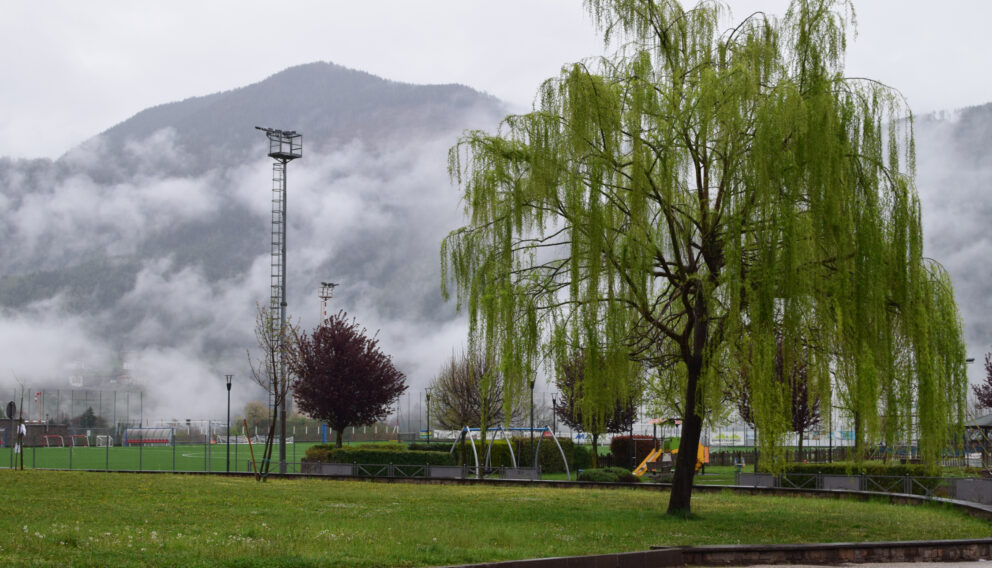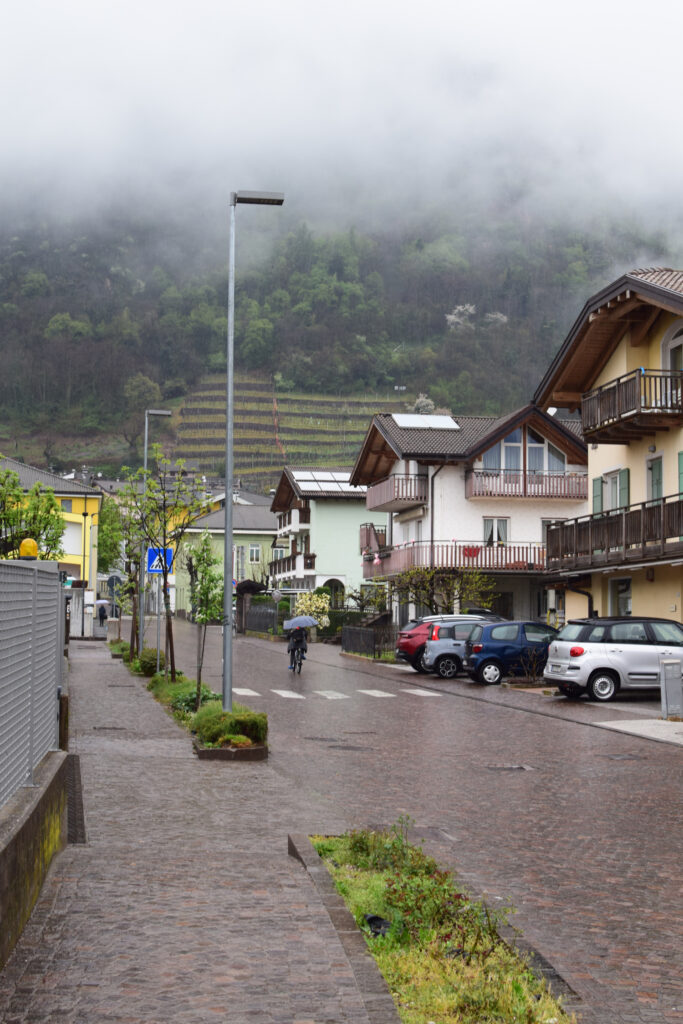Echoes of Cembra: Village Soundscape at the Turn of the Millennium

Text: Anne Tarvainen, photos: Meri Kytö
In 2000, the AEiC (Acoustic Environment in Change) project ventured into the picturesque Cembra Valley in Northern Italy to explore its unique sonic environment. The blog texts produced during this time offer a fascinating snapshot of a community nestled amidst steep hills, where sounds reflected off ancient stone walls seemed to echo a history shaped by both human activity and the constraints of nature.[1] Revisiting these texts today allows us to reflect on the transformations in Cembra’s sonic landscape—particularly when compared to earlier periods, such as 1975, documented in the Five Village Soundscapes study (Schafer 1975/2009).
One of the key observations from the AEiC blog texts is that, in 2000, the soundscape of Cembra—especially in its old part—remained characteristically human. This echoes an earlier statement from 1975, suggesting a certain continuity in the dominance of human-generated sounds. Even with a growing population and modernization, the fundamental role of human voices and live activities in shaping the auditory experience of the old village persisted. The newer part of Cembra, Campagna Rasa—built on river valley fields after 1975—likely introduced sounds associated with modern development, although the blog texts do not detail these additions.
The texts also hint at subtle shifts in the nature of the human-generated sounds. Consider the anecdote about the sound of shoes strengthened with nails on the cobblestone pavements of old Cembra.[2] These distinctive rhythmic clicks once allowed villagers to recognize who was approaching. By 2000, with the advent of the “rubber age,” only one elderly shoemaker, 87-year-old Renzo, remained—compared to eight in the past. This poignant detail suggests that a once-familiar and characteristic sound of Cembra, deeply tied to its traditional way of life, was fading. The silence where the clatter of nails once echoed speaks volumes about changes in material culture and the everyday rhythms of the village.

Interestingly, despite these subtle shifts, a member of the 1975 research group, Albert Mayr, remarked in 2000 that the “social noise” of Cembra had not changed at all in 25 years.[3] This provides a compelling insight into the enduring social fabric of the community as reflected in its soundscape. The blog describes a Saturday evening dinner near Lago Santo, filled with the sounds of a “lively Italian company that was eating, discussing and playing some kind of quiz game,” perhaps Morra. In the bar, “a group of men was singing and raising toasts so that their voices could be heard also in the restaurant.” The overall atmosphere was one of “merry shouting and laughing.” [3] Even the arrival of an accordion player, who set up a small public sound system, underscores the vibrant and often amplified nature of these social interactions. This continuity of “social noise” suggests that the vocal expressiveness of gatherings remained a defining feature of life in Cembra.
While traditional forms of acoustic communication in the Alps—such as male choir singing and even yodeling—were still present, the advent of mobile phones and text messaging had begun to reshape how people connected.[4] One anecdote describes a researcher notifying a friend on a nearby meadow that coffee was ready via a text message relayed through a local operator to a Finnish mobile phone. This starkly contrasts with the more localized and immediate form of acoustic signaling—namely singing—that two local men were demonstrating at that very moment.[4] This shift from auditory to visual communication, and from local to potentially global reach, marks a fundamental change in the sonic environment, adding the subtle pings and tones of digital devices to the existing soundscape.
The blog texts also offer glimpses into the sounds of work and daily life, revealing both continuity and transformation. The “sounds of numerous motor saws” filling the valley as men cut vine twigs [8] suggest a mechanization of agricultural practices that may have been less prominent in 1975. Similarly, the “steady humming of the engine” of a car driving through rain and hail [3], while commonplace, reflects a mode of transportation that has likely become more prevalent over time. The description of the Cantina Valle di Cembra—the cooperative wine factory established in 1952—introduces the “noise produced by the machine putting corks to the bottles” and the sound of “tractors, loaded with grapes, […] queuing to the Cantina,” which the guide likened to the noise of a highway. These industrial sounds evoke a more mechanized approach to wine production compared to the more manual methods of the past.[6]
In contrast, some sounds remained deeply tied to traditional practices. Giorgio, a landlord in Cembra, shared nostalgic memories of spending summers in forest huts, working with firewood.[7] While the method of transporting firewood down the steep 45-degree slopes had changed with the introduction of tractors,[7] the core soundscape of forest work—the singing of the cable wire as wood slid down, the threat of rolling stones, and the familiar crackle of firewood burning in the evenings—likely retained a timeless quality, linking the soundscape of 2000 to that of 1975 and earlier.[7]
The AEiC blog texts from 2000 provide valuable insights into the evolving soundscape of Cembra. While the human-centered nature of the sound environment in the old village persisted from 1975 to 2000, subtle yet meaningful changes were underway. Traditional sounds of daily life, like the rhythmic clatter of nailed shoes, were fading into memory. The vibrant “social noise” of the community endured, reflecting its strong social cohesion. Yet modern technology introduced new auditory elements and altered communication patterns. Changes in agricultural and industrial practices further shaped the sonic environment.
By reflecting on these observations from the AEiC project, we gain a deeper appreciation for how soundscapes evolve over time—shaped by technology, social habits, and economic shifts, yet still echoing the past. The sounds of Cembra in 2000 formed a tapestry woven from the enduring voices of its people and the emerging hum of a changing world—a sonic environment that undoubtedly continues to transform.
AEiC blog posts revisited
1. Acoustic Environments in Change. 1998–2004. Blog. 6villages.tamk.fi [not available].
2. Vikman, Noora. 2000. “The Cheerful Grand Old Master of Shoe Repairing.”
3. Uimonen, Heikki. 2000. “Without Canned Food or Canned Music.”
4. Uimonen, Heikki. 2000a. “Acoustic Communication in the Alps.”
5. Vikman, Noora. 2000c. “The Noisiest Heroes of the World.”
6. Järviluoma, Helmi. 2000. “La Cantina Valle di Cembra.”
7. Vikman, Noora. 2000. “Working in the Woods.”
8. Vikman, Noora & Jenni Kangas. 2000. “Weather Stories: The Day of Santa Amica.”
Other sources
Schafer, R. Murray. 1977/2009. Five Village Soundscapes. In Acoustic Environments in Change & Five Village Soundscapes, edited by Helmi Järviluoma-Mäkelä, Meri Kytö, and Heikki Uimonen, 1. ed, 283–404. Studies in Literature and Culture 14. Tampere, Finland: TAMK University of Applied Sciences.
The text has been written and edited with the assistance of AI.